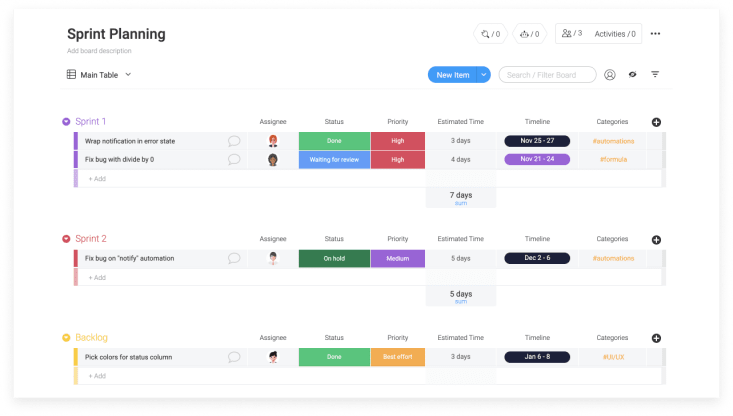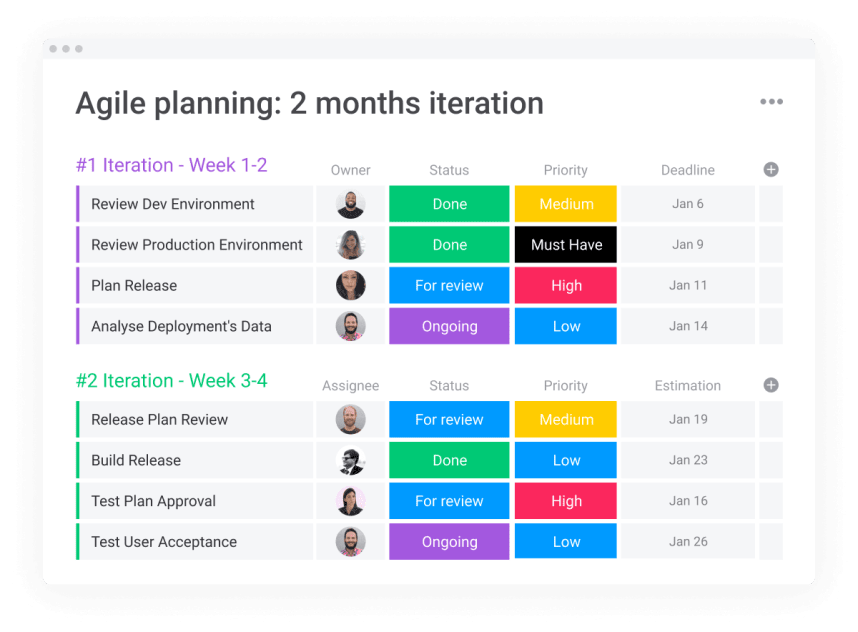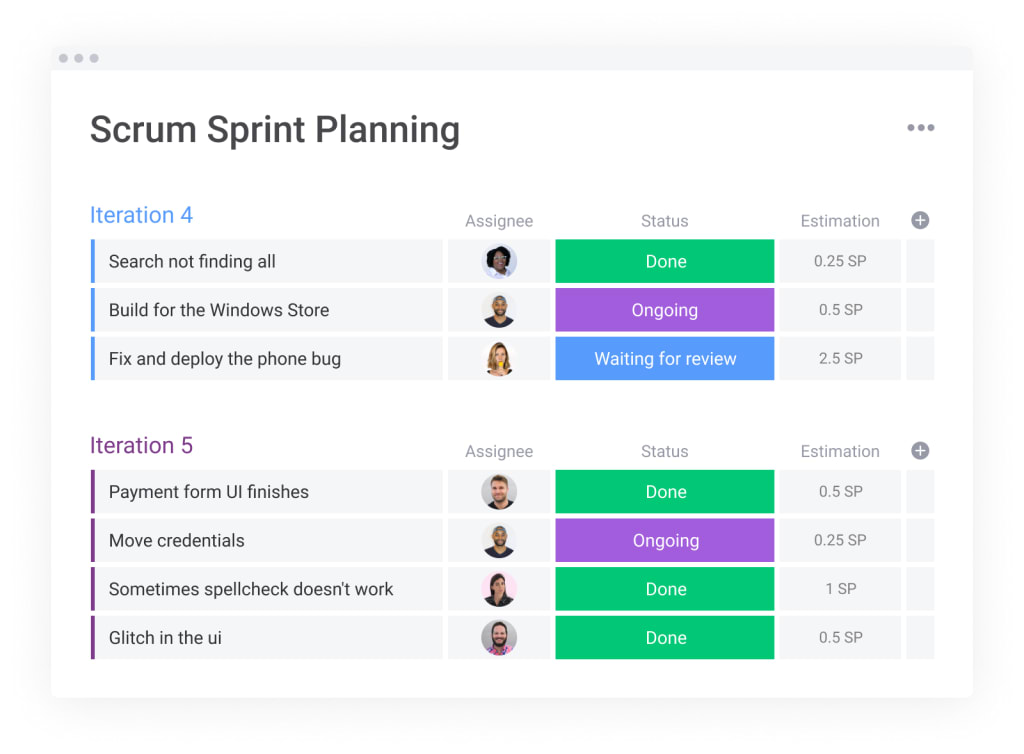For many teams wanting to make tighter deadlines, and increase product development and delivery—and who doesn’t want that!—the answer lies in Scrum methodology, but more specifically, building a Scrum team. By building a Scrum team- a group of five to nine members that develop and deliver products in increments- you can reap the benefits of high levels of communication, increased efficiency, and collaboration, all while meeting common goals and keeping stakeholders happy.
However, as the experts say, learning Scrum is easy but mastering it is difficult. Here’s how to build a successful Scrum team.
But first, let’s start with the basics.
Scrum definition: Understanding the who, why, & what of Scrum teams
Scrum is defined as a methodology that relies on teamwork to carry out projects in iterations. Typically, these iterations occur in increments based on defined priorities.
While professional Scrum is widely embraced by software development teams, you can scale Scrum principles for all kinds of work.
Many people put Scrum under the umbrella of agile project management, which focuses on teams’ adaptability and speed when producing deliverables. Scrum teams use structures, specialized skills, meetings, communication, and tools to continuously improve collaboration, speed, and project outcomes.
What is a Scrum team?
As Scrum is a project management framework, a Scrum team is the group of employees and managers who work together on a project while following Scrum processes and practices.
The optimal Scrum team size is three to nine people, not including the product owner or Scrum master.
While the type of project and its requirements will ultimately dictate the size of the Scrum team, the goal is to keep the team small enough to stay nimble and large enough to complete all of the work outlined in the sprint.
What are “sprints” in the Scrum framework?
One of the key tenets of Scrum teams is the use of “sprints” and sprint planning to drive work forward. Sprints are time-boxed periods where a Scrum teams work to complete certain aspects of a project.
The lengths vary depending on the team, complexity of work, and deadlines, but sprints typically last two weeks.
Essentially, sprints help Scrum teams organize broad-scale projects into bite-sized pieces.
Breaking down projects into sprints has two main benefits:
- Scrum teams have better organization and efficiency
- It provides value to users or stakeholders along the way, instead of waiting until the end of a project or software development cycle

How does the team run sprints? Through artifacts.
Scrum artifacts are information that help the Scrum team and stakeholders better understand the project, the completed activities, and the upcoming.
There are three main artifacts in the Scrum framework, including:
- Product backlog:
The complete list of all of the project elements teams need to produce before the project ends. In software development, the product backlog includes all the functionalities that remains to be added to the product. In other types of projects, the product backlog refers to its corresponding deliverables.
When planning sprints, product owners will decide the focus of each sprint after prioritizing items in the product backlog.
- Sprint backlog:
This list clarifies the priorities and tasks that Scrum team members need to complete within each sprint.
Every day during the Scrum meeting, each team member reports on their progress to help ensure items in the sprint backlog are completed by the end of the sprint.
- Product increment:
This is the sum of all of the items in the product backlog that are completed during a sprint, combined with the value of what was produced in the previous sprints.
Before something is completed, it must meet the Scrum team’s definition of “done,” which means it must offer value and be in useable condition.
Ultimately, each increment helps the team move the project toward achieving its final vision or goal.

What is the Scrum team structure?
The cross-functional, collaborative nature of Scrum teams is designed for flexibility, creativity, and productivity. It places value in feedback, self-reflection, and assessment throughout the project duration to maximize potential.
Scrum team roles and responsibilities
Although it is valuable to have teams that are cross-functional, in Scrum teams, there are distinct roles that guide the team through each iteration to the final successful project outcome.
Scrum master:
Traditionally, teams that deploy the Scrum method are led by a Scrum master, who is responsible for promoting the Scrum methodology, facilitating daily stand-up meetings, and improving the efficiency of each sprint.
However, many teams have realized that with the right tools, proper guidelines, and a high level of individual accountability, Scrum teams that take a self-managed approach can achieve even greater efficiency and agility.
While Scrum masters may be helpful for creating a foundation of Scrum, teams where each person takes full ownership of their role can also maximize the benefits of the methodology.
This is the approach we take among our Scrum teams at monday.com. By encouraging each team member to take full accountability for their tasks, give updates on their progress, proactively solve problems, and collaborate efficiently, we’ve been able to boost team success without Scrum masters.
Product owner:
This title is most often used within Scrum teams that are developing new software, apps, or technologies. However, product owners can also refer to project managers, or those who assume accountability for the progress, outcomes, and experience of those involved.
Within Scrum teams, the product owner creates the vision for the value the project will bring. Their main duties are:
- Setting the priorities and providing directions to the rest of the team on what each sprint will cover
- Managing the Scrum backlog, which lists all of the project items that have yet to be completed
- Communicating the needs of users, customers, organizational stakeholders, or leaders to the Scrum team to ensure the right value is being delivered
Developers:
The development team is essentially the group of employees who carry out the work within each sprint. For software development projects, developers literally mean software engineers. But when Scrum is applied to other realms of work, the “developers” are those that execute each increment of the project. They can include information system specialists, designers, writers, or virtually any role.
Developers’ primary responsibilities are to:
- Carry out the work assigned in each sprint to guide the project toward completion
- Be transparent about progress and potential issues during the daily Scrum meetings, where each team member explains what they have done so far and what they plan to do next
How should Scrum teams plan work to be performed within sprints?
As the name implies, sprints help facilitate speed. By tackling work in an incremental fashion, your team will avoid the productivity slump that usually occurs midway through projects due to dwindling motivation or poor teamwork.
To get the maximum benefits from the Scrum framework, Scrum teams must be thoughtful and deliberate about how they plan their sprints.
To this end, product owners are responsible for creating the Scrum backlog, which lists every element of the project, as well as its resource requirements, time estimations, and level of complexity. Then, he or she will prioritize each item in the backlog into different sprints.
The main idea is that by the end of each sprint, the Scrum team will produce valuable, usable deliverables. If the Scrum team is building an app, each sprint might produce a new, fully functional feature that users can begin using. If the team is creating a marketing campaign, the first sprint might produce a landing page while the second finishes LinkedIn ads.
Whatever your project is, if you care about speed, the first key is effective prioritization. The second is optimal collaboration. In the daily Scrum meetings, after each sprint, and everything in between, each member of the Scrum team must communicate routinely on progress, be proactive about solving issues, and take accountability for their role.

What solutions do I need to manage a Scrum team?
Think of scrum as a framework — a scrum guide if you will— with a set of principles that teams can adopt to improve project management and product development. Your ability to successfully adopt scrum depends heavily on which tools you use to manage the scrum team’s work, monitor progress, and facilitate communication.
Having tools that facilitate teamwork, allow you to visualize work and progress, and stay on top of tasks and priorities within each sprint is essential to managing a Scrum team effectively.
Traditional project management software falls far short of the needed capabilities to effectively lead Scrum. While they might allow you to list deadlines or prioritize tasks, the vast majority of project management tools don’t offer features for visualizing progress, communicating with teammates, sharing files and information, or automating routine tasks.
monday.com has changed the game for Scrum and with their product management software has quickly ascended as a mission-critical tool for Scrum masters across all types of work. By helping each team member stay organized, accountable, and engaged in their work, monday.com enables each person on the Scrum team to work at the highest level and at optimal speed.
Is your Scrum team ready to seamlessly sail through sprints?
